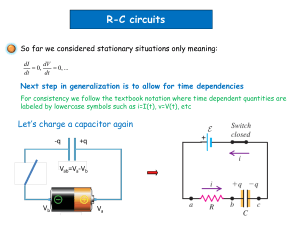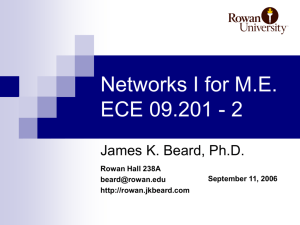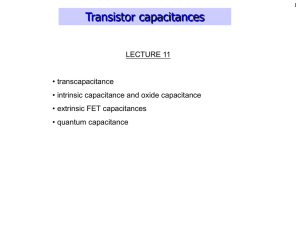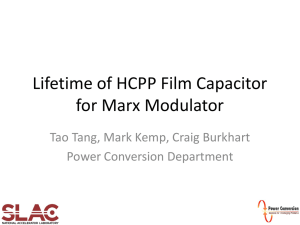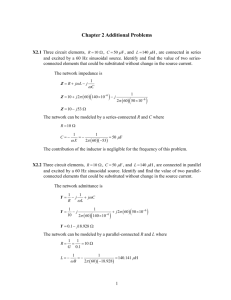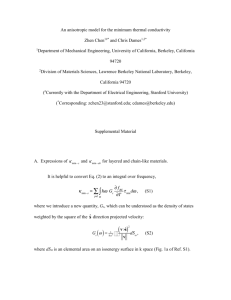Capacitors and capacitance
advertisement
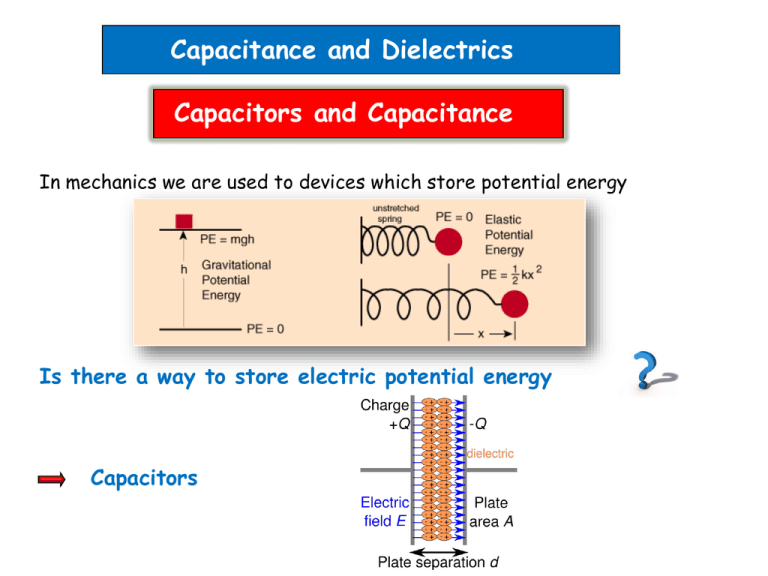
Capacitance and Dielectrics Capacitors and Capacitance In mechanics we are used to devices which store potential energy Is there a way to store electric potential energy Capacitors Any 2 conductors insulated from each other form a capacitor can be realized by an insulating materials (dielectric) or vacuum In circuit diagrams a capacitor is represented by the symbol: Let’s charge a capacitor -Q +Q Vab=Va-Vb Vb Va Remember our electric field calculations for various charged objects E ( x, y 0) x Q ex 4 0 r 3 Q E ex 1 2 2 R 0 2 R / x 1 1 We always find E Q b Since Va Vb E dr voltage Vab Va Vb Q a Capacitance C SI unit 1F=1C/V Q Vab depends only on geometry and dielectric properties, not on charge read F=Farad in honor of Michael Faraday Capacitance is an intuitive characterization of a capacitor. It tells you: how much charge a capacitor can hold for a given voltage (potential difference). The more the higher the capacitance Calculating capacitance According to C Charge density Q/ A +++++++++++++++++++++++++ Parallel-plate capacitor the major task in calculating C is calculating Vab ------------------------------------------- Q Vab Homogeneous field, E=/0 for the limit d<< plate dimensions Using b Va Vb E d r a Vab Ed d Qd 0 A 0 d We obtain the capacitance C of a parallel-plate capacitor in vacuum as A C 0 d Note: 1F is a huge capacitance. More typical values are 1µF=10-6F to 1pF=10-12F Demonstration: parallel-plate capacitor A few slightly more involved examples Capacitance of a spherical capacitor Step 1: calculate the electric field using Gauss’s law between the 2 spheres E dA Q 0 Image from http://hyperphysics.phy-astr.gsu.edu/hbase/electric/capsph.html Q E 4 r Q 0 E 4 0 r 2 2 for arb Step 2: calculate the voltage Vab for a given amount of charge Q on the spheres b Vab a Qdr Q 1 4 0 r 2 4 0 r Step 3: applying C Q Vab b a C Q 1 1 4 0 a b 4 0 4 0ab 1 1 ba a b Clicker question Does an isolated (individual) charged sphere have capacitance? 1) No, where would the electric field lines end? 2) Yes, I just don’t know the value 3) Yes, it is a special case of C in the limit b-> 4 0 1 1 a b Image from http://hyperphysics.phy-astr.gsu.edu/hbase/electric/capsph.html Capacitance per length of a cylindrical capacitor (coaxial cable) Step 1: calculate the electric field using Gauss’s law Q / L E dA Q 0 Cylinder with a<r<b L Q/L L E 2 rL 0 E 2 r 0 Step 2: calculate the voltage Vab b dr Vab ln 2 0 r 2 0 a a b C Q Step 3: applying L LVab Vab C 2 0 L ln b a C 1 55.6 pF / m b L ln a Typical value for antennas, VCRs 69pF/m Clicker question How did I like the first midterm exam? A) I have a thing for midterms, this one rocked as usually* B) The midterm was hard and unfair. C) The midterm was as expected D) I hate exams and this one was particularly bad. Hate it, hate it, hate it. *
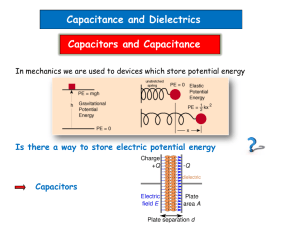
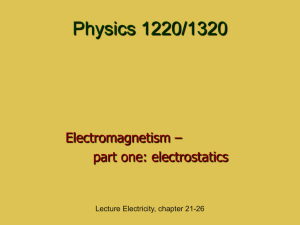


![Sample_hold[1]](http://s2.studylib.net/store/data/005360237_1-66a09447be9ffd6ace4f3f67c2fef5c7-300x300.png)
